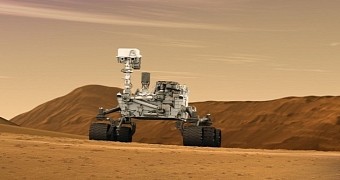Just yesterday, NASA announced that its Curiosity rover had finally reached Mars' Mount Sharp and was resting for a while before putting on its hiking boots and setting out to explore it.
The Curiosity rover left Earth in November, 2011, and reached the Red Planet in August, 2012. It landed in the Gale Crater, which measures about 154 kilometers (95.6 miles) across and is somewhere between 3.5 and 3.8 billion years old.
Since arriving on Mars, the car-sized robotic rover has been keeping itself entertained collecting information concerning Mars' climate and geology, and snapping pictures of the local landscape.
How a rover becomes a hiker
On its website, NASA explains that the Martian mountain the Curiosity rover will soon explore is about the size of Earth's Mount Rainier. It is located at the center of the Gale Crater, which, as mentioned, served as a landing site for the robot back in 2012.
Astronomers in charge of keeping a close eye on the Curiosity rover and monitoring its every move say that the robot currently finds itself at the base of Mount Sharp. Its exact location is in the proximity of a geological formation dubbed the Murray formation.
When compared to the terrain of the Gale Crates, this formation does not sport impact scars. Besides, it is surprisingly soft. As soft as Martian terrain can be, that it. Not to beat about the bush, this formation is kind of like a nice cushion the rover will rest on until embarking on its journey.
Before going up the mountain, the Curiosity rover will take some time to explore Mount Sharp's lower slopes. Thus, the robot will journey past an outcrop called Pahrump Hills, traverse a valley, and closely examine a terrain sporting elevated areas of land known as mesas.
“We have been driving hard for many months to reach the entry point to Mount Sharp. Now that we've made it, we'll be adjusting the operations style from a priority on driving to a priority on conducting the investigations needed at each layer of the mountain,” explains researcher Jennifer Trosper.
“Curiosity now will begin a new chapter from an already outstanding introduction to the world. After a historic and innovative landing along with its successful science discoveries, the scientific sequel is upon us,” adds NASA scientist Jim Green.
Why explore Mount Sharp
Apart from helping scientists figure out whether environmental conditions on Mars are or have ever been microbial-life friendly, Curiosity's work on the Red Planet is expected to pave the way for future space missions involving astronauts.
In fact, NASA believes that it will succeed in landing humans on the Red Planet sometime in the 2030s. In order for this to happen, astronomers must first become familiar with the local landscape and with how Mars' appearance has changed over millennia of evolution.

 14 DAY TRIAL //
14 DAY TRIAL //